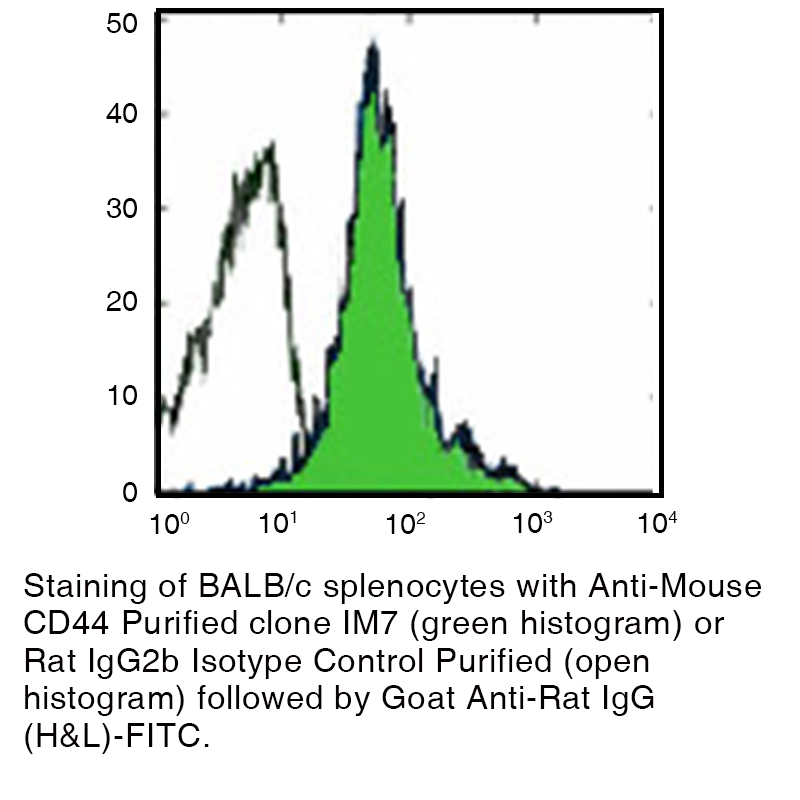Anti-Mouse/Human CD44 Antibody (Clone IM7) – Purified in vivo GOLD™ Functional Grade
Anti-Mouse/Human CD44 Antibody (Clone IM7) – Purified in vivo GOLD™ Functional Grade
Product No.: C382
- -
- -
Clone IM7 Target CD44 Formats AvailableView All Product Type Monoclonal Antibody Alternate Names Hermes, Pgp-1, H-CAM, HUTCH-1, ECMR III, gp85, Ly-24 Isotype IgG2b κ Applications CyTOF® , ELISA Det , FC , ICC , IHC FF , IHC FFPE , in vivo , IP , PhenoCycler® , WB |
Data
- -
- -
Antibody DetailsProduct DetailsReactive Species Human ⋅ Mouse Host Species Rat Recommended Isotype Controls Immunogen Dexamethasone-induced myeloid leukemia M1 cells Product Concentration ≥ 5.0 mg/ml Endotoxin Level < 1.0 EU/mg as determined by the LAL method Purity ≥95% monomer by analytical SEC ⋅ >95% by SDS Page Formulation This monoclonal antibody is aseptically packaged and formulated in 0.01 M phosphate buffered saline (150 mM NaCl) PBS pH 7.2 - 7.4 with no carrier protein, potassium, calcium or preservatives added. Due to inherent biochemical properties of antibodies, certain products may be prone to precipitation over time. Precipitation may be removed by aseptic centrifugation and/or filtration. Product Preparation Functional grade preclinical antibodies are manufactured in an animal free facility using in vitro cell culture techniques and are purified by a multi-step process including the use of protein A or G to assure extremely low levels of endotoxins, leachable protein A or aggregates. Storage and Handling Functional grade preclinical antibodies may be stored sterile as received at 2-8°C for up to one month. For longer term storage, aseptically aliquot in working volumes without diluting and store at -80°C. Avoid Repeated Freeze Thaw Cycles. Country of Origin USA Shipping Next Day 2-8°C RRIDAB_2737485 Applications and Recommended Usage? Quality Tested by Leinco FC The suggested concentration for this IM7 antibody for staining cells in flow cytometry is ≤ 0.25 μg per 106 cells in a volume of 100 μl or 100μl of whole blood. Titration of the reagent is recommended for optimal performance for each application. WB The suggested concentration for this P84 antibody for use in western blotting is 1-10 μg/ml. Additional Applications Reported In Literature ? CyTOF® ELISA Det ICC IP IHC FF IHC FFPE Additional Reported Applications For Relevant Conjugates ? CODEX® Each investigator should determine their own optimal working dilution for specific applications. See directions on lot specific datasheets, as information may periodically change. DescriptionSpecificity Clone IM7 recognizes an epitope common to alloantigens and all isoforms of CD44 that is located between amino acids 145 and 186. Antigen Distribution CD44 is expressed on all leukocytes, endothelial cells, hepatocytes, and mesenchymal cells in addition to B-cells, monocytes, macrophages and certain subsets of thymocytes and peripheral T-cells. Mice with the Ly-24.1 allotype have high densities of CD44+ T-cells. Background CD44 is an 80-95 kD glycoprotein that plays a role in various cellular functions including lymphocyte activation, recirculation and homing, hematopoiesis, and tumor metastasis. CD44 interacts with osteopontin, collagens, and matrix metalloproteinases (MMPs) and is a receptor for hyaluronic acid. Transcripts for this gene go through intricate alternative splicing that result in a variety of functionally distinct isoforms, including those which may be related to tumor metastasis. These splice variants of CD44 function as receptors under hemodynamic flow conditions that are significant to the development of cancer metastasis. Hence, it is thought that anti-CD44 tumor-specific mAbs may have therapeutic potential. This therapeutic potential of anti-CD44 mAbs is evident in some animal experiments demonstrating a reduction in malignant activities of various neoplasms when CD44 was targeted by a combination of mAbs, antisense oligonucleotides, and CD44-soluble proteins. It has been reported that high levels of CD44 on leukemic cells fuel leukemia production. Notably, various cancer studies show conflicting results pertaining to level of CD44 expression and its correlation with disease prognosis. Before anti-CD44 therapy can be applied to human cancers, it is essential to resolve this inconsistency. Antigen DetailsLigand/Receptor Hyaluronan, MIP-1β, fibronectin, collagen Function Leukocyte attachment and rolling on endothelial cells, stromal cells and ECM PubMed NCBI Gene Bank ID UniProt.org Research Area Cell Adhesion . Cell Biology . Immunology . Stem Cell References & Citations1. Trowbridge, I. et al. (1982) Immunogenetics 15:299
2. Lesley, J. et al. (1988) Cell Immunol. 112:40 Technical Protocols |
Related Products
- -
- -
Prod No. | Description |
|---|---|
S211 | |
R1364 | |
I-1034 | |
C247 | |
F1175 | |
R1214 | |
S571 |
Formats Available
- -
- -
Prod No. | Description |
|---|---|
C1894 | |
C349 | |
C251 | |
C252 | |
C253 | |
C254 | |
C1886 | |
C1887 | |
C1888 | |
C1890 | |
C1892 | |
C501 | |
C382 | |
C2368 |
 Products are for research use only. Not for use in diagnostic or therapeutic procedures.
Products are for research use only. Not for use in diagnostic or therapeutic procedures.



